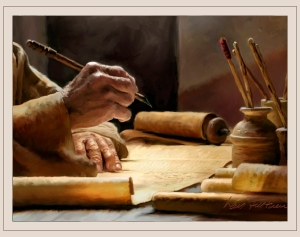Why write? What function does it serve? It is a lonely task, often unheralded, frequently ignored, and rarely profitable. So why do it?
The fundamental purpose of writing is to record information and transmit such information over time and distance. Writing allows for non-verbal exchange where the communicator need not be present at the time or in the place in which the information is received. Writing also allows for “permanence” in that the written record may survive the life of the writer. Last, writing allows for “accuracy” in that the words of the writer are preserved and may be checked against for deviations from his or her account.
So, it would seem that if this all comprises the sole function of writing and therefore the reason for reading, then all written materials would be non-fictional.
But, that is not the case.
Fiction exists. Fiction is preserved. Fiction thrives. Fiction is sought and desired. Fiction is created. And fiction is honored.
Why?
The writing of fiction first appeared in storyteller form. Tales were handed down by a verbal tradition. Later, writing fiction into a recorded format developed–whether inked on animal skin, painted on walls, or chiseled into rock. This craft and practice arose so that tales could be disseminated over larger distances and to greater numbers of “listeners” and so that tales could be preserved for posterity in their “original” form.
As writers, we must ask ourselves: Why does the public seek our stories? The answer informs our writing. If we know why readers read, then we know what need or desire we must fulfill in order for our work to be accepted. The better we fulfill those needs and desires, the higher chance we have for critical and financial success and for longevity of our body of work.
The answer is neither unexpected nor astonishing. But it must be borne in mind.
Writing is an art. It is an expression of one individual’s viewpoint, contemplation, emotion, idea, question, or conclusion or any combination thereof.
If we accept that writing is an art, then all art forms share this definition of expression.
So, why is there an audience for any of the arts? Why attend a concert? Why see a film? Why go to an art gallery? Why go to a play? Why watch a ballet? Why read a novel?
The motivation is a common characteristic uniting all the arts.
THE ANSWER: Audiences experience art in order to have an emotional experience. Audiences want to be moved. They want to laugh and cry and cheer and jeer. They are willing to “suspend their disbelief” and accept artifice for reality for a limited time and on a limited scale so that they may live vicariously and be provoked by art.
Upon the storyteller tradition, audiences may ask themselves what is being expressed? They want to understand not only “plot” but message. They will look for the “point.” Finally, they will ask themselves how does the given expression in its given medium relate to their own lives? What does it “say” to them?
Great art elicits emotional response and triggers introspection.
Art can be used as a device not only to communicate ideas and conclusions and beliefs but also to cause examination of those same things.
Art can be used to educate, but the artists must not be didactic or the audience will wander.
Art is entertainment. The fundamental function is to drive an emotional response. To create empathy and to carry the reader on a journey.
Therefore, as a writer, my primary goal is to make the reader feel. I want to give my readers an emotional roller-coaster ride. I want to build anticipation, put them through twists and turns, spin and jostle, cradle and hurl, soothe, jar, and shock. I want to involve my reader and make them feel at risk, while all the while there is no real danger. I want to take my readers in my hands and propel them over a broad range of emotional experiences running the gamut between love and hate, sorrow and joy, fear and anticipation.
I want to thrill my readers’ hearts.
I also want to tickle their brains. I want them to think. I want them to examine their beliefs and want them to question society and their place in the universe. I want them to question reality.
By the time my readers reach the final page of any novel which I have written, I want them feeling that they have lived through an amazing experience. I want them to be “satisfied.” By giving into the narrative and allowing themselves to live with and as my characters, I want them to feel as though they have lived other lives.
I want my readers wanting more.
To find out more about Marc Royston and his latest novel, be sure to follow the Wizard’s Workshop.
BECOME AN APPRENTICE! Click FOLLOW on the right of your screen to stay tuned for updates and for exclusive material on Marc Royston’s A Wizard’s Life, an epic adult fantasy soon to be released as a serialized novel.

[…] Purpose (marcroyston.wordpress.com) […]